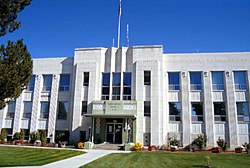Demographics
Historical population| Census | Pop. | Note | %± |
|---|
| 1880 | 879 | | — |
|---|
| 1890 | 3,836 | | 336.4% |
|---|
| 1900 | 6,882 | | 79.4% |
|---|
| 1910 | 11,101 | | 61.3% |
|---|
| 1920 | 9,424 | | −15.1% |
|---|
| 1930 | 7,962 | | −15.5% |
|---|
| 1940 | 8,853 | | 11.2% |
|---|
| 1950 | 8,576 | | −3.1% |
|---|
| 1960 | 8,378 | | −2.3% |
|---|
| 1970 | 7,633 | | −8.9% |
|---|
| 1980 | 8,803 | | 15.3% |
|---|
| 1990 | 8,550 | | −2.9% |
|---|
| 2000 | 9,977 | | 16.7% |
|---|
| 2010 | 10,198 | | 2.2% |
|---|
| 2020 | 10,500 | | 3.0% |
|---|
| 2024 (est.) | 11,539 | [4] | 9.9% |
|---|
|
2020 census
As of the census [10] of 2020, there were 10,500 people in 4,112 households living in the county. The population density was 7 people per square mile (2.7 people/km2). There were 4,138 housing units at an average density of 3 units per square mile (1.2 units/km2). The racial makeup of the county was 87.61% White, 1.03% Asian, 0.66% Native American, 0.10% Black or African American, 0.07% Pacific Islander, 8.17% from other races, and 2.36% from two or more races. 13.75% of the population were Hispanic or Latino of any race. 15.7% were of German, 14.3% English, 10.1% American and 7.7% Irish ancestry.
There were 3,762 households, out of which 32.7% had children under the age of 18 living with them, 60.7% were married couples living together, 8.2% had a female householder with no husband present, and 27.2% were non-families. 23.5% of all households were made up of individuals, and 13.30% had someone living alone who was 65 years of age or older. The average household size was 2.61 and the average family size was 3.10.
In the county, the population was spread out, with 27.4% under the age of 18, 7.20% from 18 to 24, 23.4% from 25 to 44, 24.3% from 45 to 64, and 17.70% who were 65 years of age or older. The median age was 39 years. For every 100 females there were 95.80 males. For every 100 females age 18 and over, there were 93.0 males.
The median income for a household in the county was $30,625, and the median income for a family was $35,542. Males had a median income of $27,222 versus $18,053 for females. The per capita income for the county was $15,464. About 10.00% of families and 13.30% of the population were below the poverty line, including 16.60% of those under age 18 and 9.90% of those age 65 or over.
2010 census
As of the 2010 United States census, there were 10,198 people, 4,034 households, and 2,803 families living in the county. [11] The population density was 7.0 inhabitants per square mile (2.7/km2). There were 4,529 housing units at an average density of 3.1 units per square mile (1.2 units/km2). [12] The racial makeup of the county was 86.6% white, 1.0% American Indian, 0.9% Asian, 0.2% black or African American, 9.1% from other races, and 2.2% from two or more races. Those of Hispanic or Latino origin made up 16.8% of the population. [11] In terms of ancestry, 20.0% were English, 18.2% were German, 14.8% were Irish, and 9.6% were American. [13]
Of the 4,034 households, 30.4% had children under the age of 18 living with them, 54.9% were married couples living together, 9.7% had a female householder with no husband present, 30.5% were non-families, and 25.8% of all households were made up of individuals. The average household size was 2.50 and the average family size was 2.99. The median age was 43.6 years. [11]
The median income for a household in the county was $36,542 and the median income for a family was $46,970. Males had a median income of $36,765 versus $26,406 for females. The per capita income for the county was $20,015. About 10.9% of families and 13.2% of the population were below the poverty line, including 15.6% of those under age 18 and 9.6% of those age 65 or over. [14]
2020 census
Note: the US Census treats Hispanic/Latino as an ethnic category. This table excludes Latinos from the racial categories and assigns them to a separate category. Hispanics/Latinos can be of any race.
As of the 2020 United States census, there were 10,500 people, 4,035 households, and 2,708 families residing in the county.
This page is based on this
Wikipedia article Text is available under the
CC BY-SA 4.0 license; additional terms may apply.
Images, videos and audio are available under their respective licenses.




